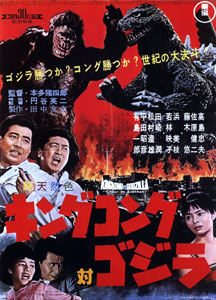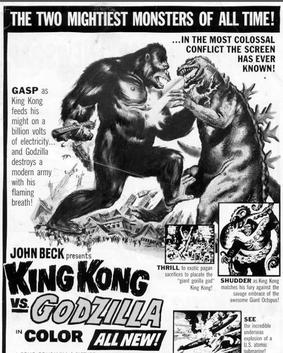| Japanese Poster | US Poster |
|---|---|
 |  |
The first full-color entry to the Godzilla series combines the two titans of cinema into one film, pitting the classic RKO King Kong monster against Toho's atomic powered horror. The movie debuted in 1962 and originally started life as King Kong vs Frankenstein, pitting an entirely different kind of monster against the greatest ape.
The Japanese cut of the film features many satirical elements, mocking Japanese television of its time which featured a quest for outlandish ratings. The original American release downplayed those elements and treated the movie as a more serious endeavor.
The film starts off by introducing us to the two monsters, with the head of a pharmaceutical company sending an expedition into the south seas, to Faro Island, in thee hopes of finding a giant monster. Godzilla on the other hand is awakened by a submarine snooping too close to the icy tomb from the previous movie, breaking free of it, and immediately beginning his campaign of terror. The two monsters battle each other, of course, smashing their way through miniature sets.
This film sets the tone and defines the formula for many succeeding Godzilla films from the Showa-era. The monsters clash and the humans are forced to try to pick a side in the conflict. This basic formula would be revisited time and again in Godzilla films.
The introduction of color to the world of Godzilla helps to give the movie a modern look, but it also showcases the shortcomings of the suit-mation style of film. In black and white, and with grainy footage, both the preceding entries into the serious could bring a menace to the giant monsters at play. Color on the other hand highlights the sometimes shabby-appearance of the monster suits and brings the nature of the models and miniature work to the fore.
While the film is heavily satirical and brings in those themes analyzing the nature of business and why a company that makes pharmaceuticals feels it needs a PR stunt to complete, it also sets the trend in motion for succeeding films to become more and more child-friendly. The fight between Kong and Godzilla features comedic elements such as the two monsters lobbing a boulder back and forth, as if playing a giant game of volleyball. This is a strong contrast to the prior two movies which rarely deviated from their serious tone.
There isn't much to say about the acting or the effects. It's all competently done and executed.
One highlight of the effects and action is the giant octopus sequence, where puffs of hot air were used to direct the octopus's motion around the set. This does have a bit of a sad note to it, the effect director Eiji Tsuburaya had one of the several octopi used in the scene for dinner.
Another potentially controversial note has to do with old, and debunked, rumors that the US and Japanese cuts of the film have different winners. Rumors said for years that the Japanese cut had Godzilla triumphant, rather than the actual ending where it's left either ambiguous or viewed as Kong's victory. The truth is that this isn't true, the ending is substantially the same in both countries and no cut where Godzilla is the victor exists.
Overall it's a solid film, but feels out of place if watched directly after the previous two entries into the series.
I rate this film 8 Godzillas.
Your post has been manually curated by @freevoter !! Keep sharing your quality content in Blurt Blockchain heart
FreeVoter is a curation program which aim to support quality content creator in Blurt Blockchain.You can support us by delegating your BP to @freevoter !! We are sharing 90% curation reward to our Delegators.Learn more about FreeVoter and join Discord server.